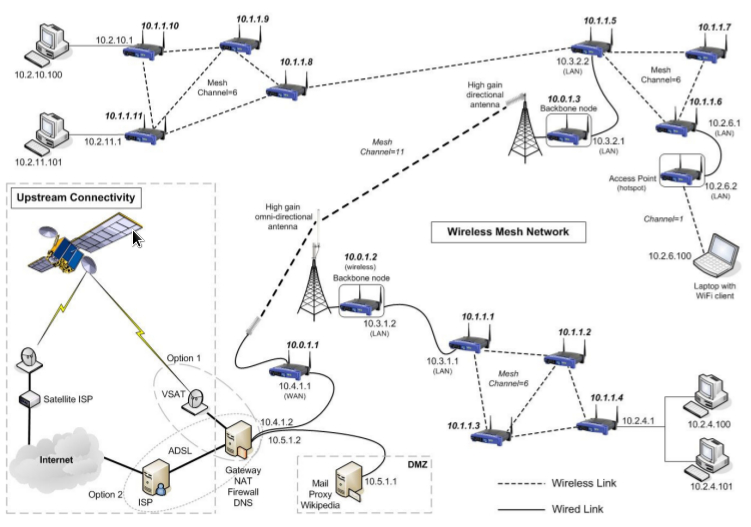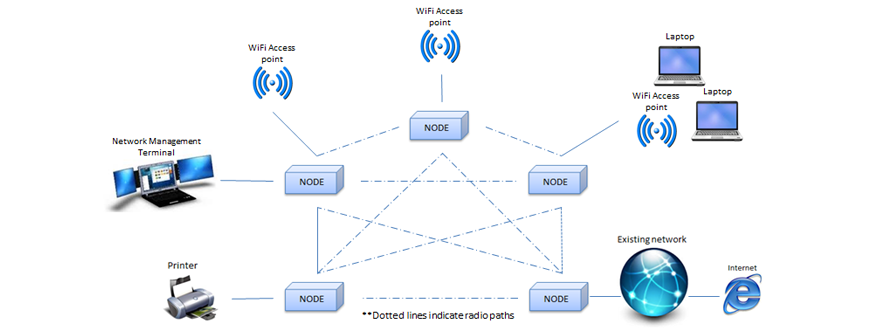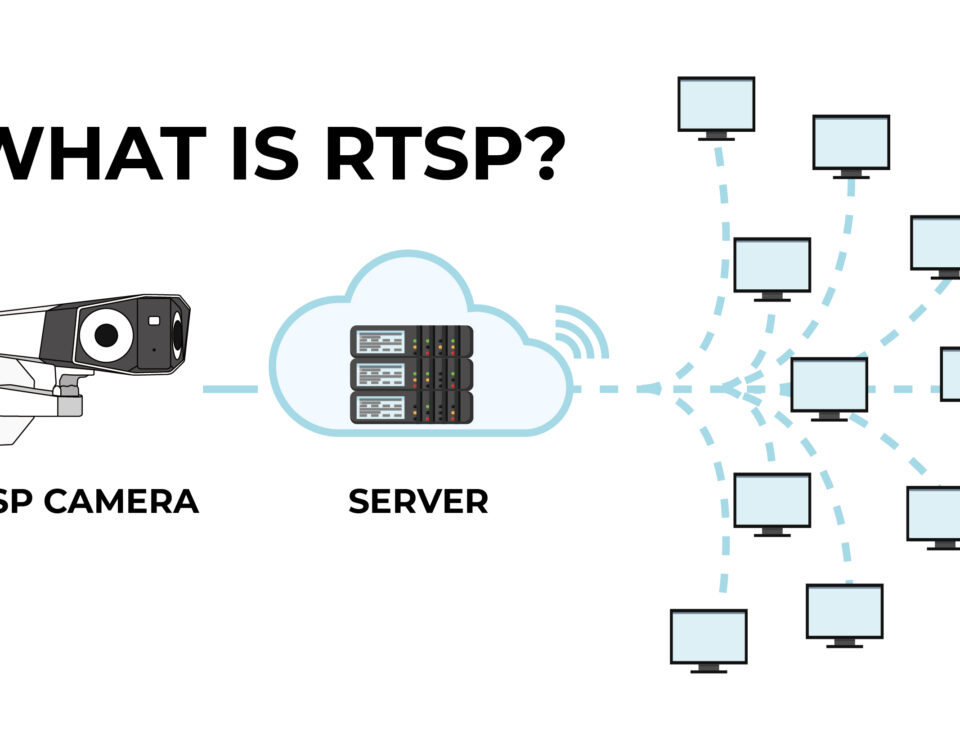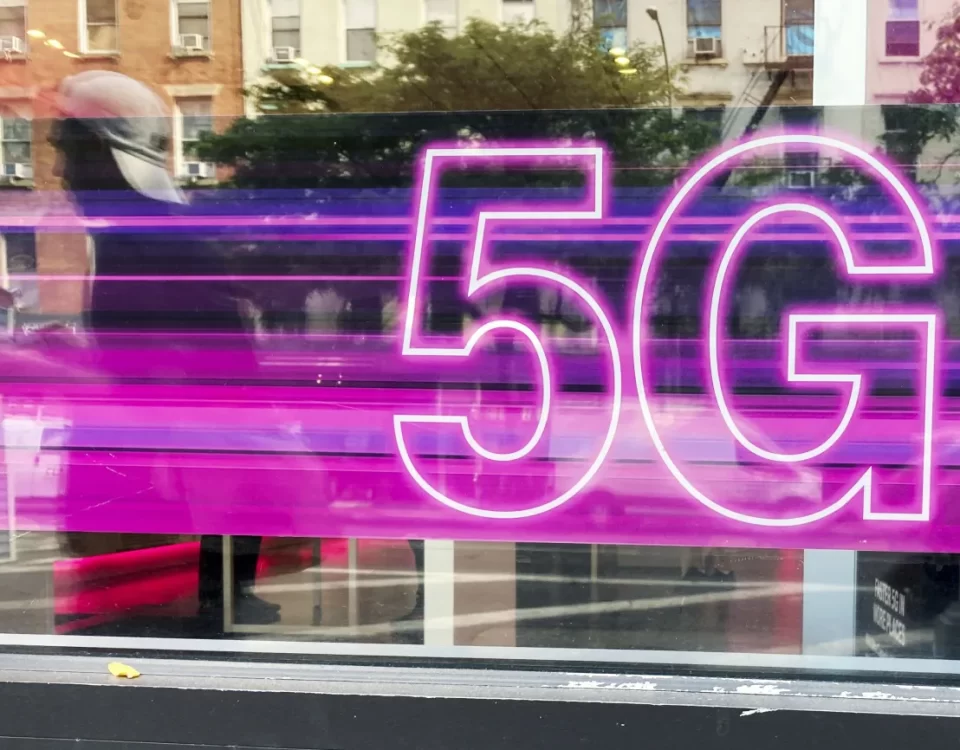
Benefits of Hybrid mobile app development
10th October 2019
PHP Framework-CodeIgniter
10th October 2019A wireless mesh network (WMN) is a communications network made up of radial nodes organized in a mesh topology. It is also a form of wireless ad hoc network.
A mesh refers to rich interconnection among devices or nodes. Wireless mesh networks often consist of mesh clients, mesh routers and gateways. Mobility of nodes is less frequent. If nodes constantly or frequently move, the mesh spends more time updating routes than delivering data. In a wireless mesh network, topology tends to be more static, so that routes computation can converge and delivery of data to their destinations can occur. Hence, this is a low-mobility centralized form of wireless ad hoc network. Also, because it sometimes relies on static nodes to act as gateways, it is not a truly all-wireless ad hoc network
Mesh clients are often laptops, cell phones, and other wireless devices. Mesh routers forward traffic to and from the gateways, which may, but need not, be connected to the Internet. The coverage area of all radio nodes working as a single network is sometimes called a mesh cloud. Access to this mesh cloud depends on the radio nodes working together to create a radio network. A mesh network is reliable and offers redundancy. When one node can no longer operate, the rest of the nodes can still communicate with each other, directly or through one or more intermediate nodes. Wireless mesh networks can self form and self heal. Wireless mesh networks work with different wireless technologies including 802.11, 802.15, 802.16, cellular technologies and need not be restricted to any one technology or protocol. See also mesh networking.

Wireless mesh networks advantages include:
- Using fewer wires means it costs less to set up a network, particularly for large areas of coverage.
- The more nodes you install, the bigger and faster your wireless network becomes.
- They rely on the same WiFi standards (802.11a, b and g) already in place for most wireless networks.
- They are convenient where Ethernet wall connections are lacking — for instance, in outdoor concert venues, warehouses or transportation settings.
- They are useful for Non-Line-of-Sight (NLoS) network configurations where wireless signals are intermittently blocked. For example, in an amusement park a Ferris wheel occasionally blocks the signal from a wireless access point. If there are dozens or hundreds of other nodes around, the mesh network will adjust to find a clear signal.
- Mesh networks are “self configuring;” the network automatically incorporates a new node into the existing structure without needing any adjustments by a network administrator.
- Mesh networks are “self healing,” since the network automatically finds the fastest and most reliable paths to send data, even if nodes are blocked or lose their signal.
- Wireless mesh configurations allow local networks to run faster, because local packets don’t have to travel back to a central server.
- Wireless mesh nodes are easy to install and uninstall, making the network extremely adaptable and expandable as more or less coverage is needed.
Features
1. Architecture
Wireless mesh architecture is a first step towards providing cost effective and low mobility over a specific coverage area. Wireless mesh infrastructure is, in effect, a network of routers minus the cabling between nodes. It is built of peer radio devices that do not have to be cabled to a wired port like traditional WLANaccess points (AP) do. Mesh infrastructure carries data over large distances by splitting the distance into a series of short hops. Intermediate nodes not only boost the signal, but cooperatively pass data from point A to point B by making forwarding decisions based on their knowledge of the network, i.e. perform routing by first deriving the topology of the network.
2. Management
This type of infrastructure can be decentralized (with no central server) or centrally managed (with a central server). Both are relatively inexpensive, and can be very reliable and resilient, as each node needs only transmit as far as the next node. Nodes act as routers to transmit data from nearby nodes to peers that are too far away to reach in a single hop, resulting in a network that can span larger distances. The topology of a mesh network must be relatively stable, i.e., not too much mobility. If one node drops out of the network, due to hardware failure or any other reason, its neighbors can quickly find another route using a routing protocol.
3. Applications
Mesh networks may involve either fixed or mobile devices. The solutions are as diverse as communication needs, for example in difficult environments such as emergency situations, tunnels, oil rigs, battlefield surveillance, high-speed mobile-video applications on board public transport, real-time racing-car telemetry, or self-organizing Internet access for communities. An important possible application for wireless mesh networks is VoIP. By using a quality of service scheme, the wireless mesh may support routing local telephone calls through the mesh. Most applications in wireless mesh networks are similar to those in wireless ad hoc networks.
4. Operation
The principle is similar to the way packets travel around the wired Internet—data hops from one device to another until it eventually reaches its destination. Dynamic routing algorithms implemented in each device allow this to happen. To implement such dynamic routing protocols, each device needs to communicate routing information to other devices in the network. Each device then determines what to do with the data it receives – either pass it on to the next device or keep it, depending on the protocol. The routing algorithm used should attempt to always ensure that the data takes the most appropriate (fastest) route to its destination.
5. Multi-radio mesh
Multi-radio mesh refers to having different radios operating at different frequencies to interconnect nodes in a mesh. This means there is a unique frequency used for each wireless hop and thus a dedicated CSMA collision domain. With more radio bands, communication throughput is likely to increase as a result of more available communication channels. This is similar to providing dual or multiple radio paths to transmit and receive data.
6. Research topics
One of the more often cited papers on Wireless Mesh Networks identified the following areas as open research problems in 2005





